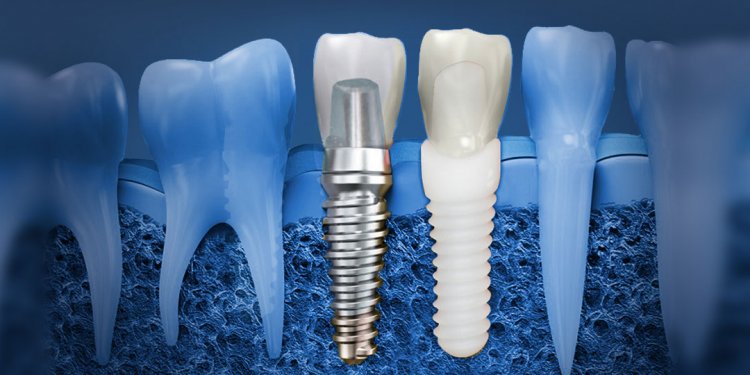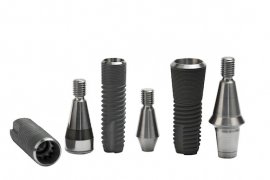
Implant materials
 The estimated reading time for this post is 8 minutes
The estimated reading time for this post is 8 minutes
Today’s modern day dental implants developed through an accidental discovery in medical research back in 1952. A Swedish doctor by the name of Branemark found that when titanium was placed into contact with bone and left undisturbed, the bone grew right against the surface making the titanium objects unremovable without cutting out the bone around the titanium. This then developed into today’s implants.
History of Dental Implant Materials
Prior to this and even since then, other materials have been tested and tried. Vitreous carbon was one material which worked very well in fusing to bone, but being brittle and having other issues made it impractical for use as a dental implant. Titanium seemed like an ideal material—its properties made it useful, practical and predictable. The initial implants were pure titanium, but they were a bit too soft so an alloy was developed to overcome the negative properties.
Today, well over 95% of the dental implants placed are titanium alloys. There are literally hundreds of implant companies and systems worldwide and when scientific and surgical protocols are followed, the success of these implants are all well over 98% even after 10 years.
Since titanium dental implants have been in use, there has not been one report of an allergy or reaction to the metal itself. Nevertheless, there are some people who have either an allergy or sensitivity to other metals (e.g. prevalence of nickel allergy is about 5%) and/or simply have concerns about any metals within the body.
Zirconium—The Metal-Free Option?
In order to allay these concerns and have an implant option for these people, several companies have conducted further research and development into “metal-free” implants. This has led to the use of another metal called zirconium, which is just one row below titanium in the chemical periodic table.. Zirconium first became popular in its crystalline cubic zirconia form due to its resemblance to a flawless diamond. For dental use, it is used in the form of zirconium oxide ZrO2. It is not pure ZrO2—there are trace amounts of another metal called hafnium (Hf) and the oxide is combined with yttrium (another metal) to improve its properties. The result is a white opaque-looking product and in this form, labeled as a ceramic, although there are metal atoms within the material.
The material is very strong and hard and has also been used for making crowns and bridges. With the search for alternative implant materials, it was discovered that zirconia also fused to bone (osseointegrated) much like titanium. It first became approved for use in Europe in 2008 and in Canada in 2013.
Titanium and Zirconia—Pros and Cons
Both materials can integrate with bone with equal success provided certain protocols are followed. We do, however, have a much longer history with titanium. Some of my patients have titanium that is still functioning after 20-35 years. We may find the same success with zirconia, but until the material has been tested for the same amount of time as titanium, we simply will not know.
Titanium implants are much more versatile than zirconia because they can be made as one piece or two-piece systems. In two-piece systems, the implant replaces the root and is generally placed at the level of the underlying bone. Attached to this is a post or abutment—the part that sticks through the gums and is used to support or attach the teeth.
Two piece systems are a lot more versatile and offer many more options prosthetically. They can be used for overdentures (removable teeth) that snap into place as well as permanent teeth that are cemented or screwed onto the implants. Additionally, the implant can even be placed slightly off-angle and an angled or customized post can be fitted to correct it. Zirconium implants can also be modified if they are slightly off but are not as prosthetically ideal as what can be done with a separate post.
In some cases, placing an implant slightly off-angle is not a surgical error, but rather a necessity due to the volume and location of bone in the implant site. I could go on for pages, but basically titanium implants offer much more versatility with the final teeth and flexibility with their surgical placement.

















